Register to access any of these courses from the home page.
Available Courses
Accepting, Rejecting & Delegating a Work Assignment - A Guide for Nurses
Credit hours: 1.10
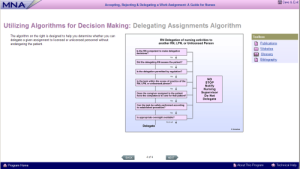
The practice of nursing is dynamic. It is continuously evolving in response to the changing needs, demands, and resources of our society. Clarifying the responsibilities of the licensed nurse (registered nurse and licensed practical nurse) is sometimes a challenge for nurses and their employers.
This educational activity utilizes MNA materials including Accepting, Rejecting & Delegating a Work Assignment: A Guide for Nurses, which addresses the questions and concerns of Massachusetts nurses regarding decision-making related to work assignments and the delegation of nursing acts. The Guide was developed collaboratively by the Task Force on Accepting and/or Rejecting an Assignment and the Congress on Nursing Practice.
This educational activity and the booklet Accepting, Rejecting & Delegating a Work Assignment: A Guide for Nurses are based on the premise that each nurse is responsible and accountable for making decisions and for practicing in accordance with the Massachusetts Board of Registration in Nursing (the Board), Nurse Practice Act (NPA) regulations, and with the nurse’s educational background, competencies, and experience. Although the Guide is not legally binding, it is consistent with nursing practices set forth in the NPA.
Hazardous Drugs
Credit hours: 0.70
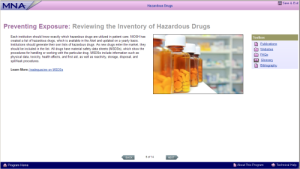
Patients who are prescribed any medications are urged to learn the side effects and avoid harmful interactions so they can use the medications safely. However, patients and their families are not the only group that can be endangered by medications. The health care providers who prepare and sometimes administer these medications can find themselves at risk of adverse health effects from exposure.
The adverse health effects of exposure to hazardous drugs include long-term skin damage, infertility, miscarriages, birth defects, and even cancers such as leukemia, and can affect all health care providers, including physicians, nurses, pharmacists, OR personnel, environmental services personnel, veterinarians, and even shipping and receiving personnel. Given the wide range of possible exposure, health care facilities need a comprehensive plan for careful handling of hazardous drugs to avoid accidental exposure.
Linking Nurses' Safety to Patient Safety
Credit hours: 1.10
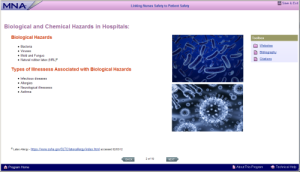
We as nurses are cognizant that according to the Institute of Medicine report in 1999, that medical errors result in the death of between 44,000 and 98,00 patients every year. According to the National Institute for Occupational Safety and Health (NIOSH): Health care is the second-fastest-growing sector of the U.S. economy, employing over 12 million workers. Women represent nearly 80% of the health care work force. Health care workers face a wide range of hazards on the job, including needlestick injuries, back injuries, latex allergy, violence, and stress.
Although it is possible to prevent or reduce health care worker exposure to these hazards, health care workers actually are experiencing increasing numbers of occupational injuries and illnesses. Rates of occupational injury to healthcare workers have risen over the past decade. By contrast, two of the most hazardous industries, agriculture and construction, are safer today than they were a decade ago.
This program will look at the link between nurses' safety and patient safety and provide information on how to locate and implement strategies to support safety for both.
Nanotechnology: Benefits, Nursing Implications and Safety Practices to Protect both Patients and Workers
Credit hours: 1.00

The purpose of this program is to help nurses understand the basics of nanotechnology; to recognize both its benefits and risks, its applications in healthcare, as well as nursing implications.
This program discusses:
- Nanotechnology and Nanomedicine,
- Nanoparticles and their application in medical and other consumer products,
- Benefits of the technology,
- Potential health and safety risks,
- Nursing and regulatory implications.
Recognizing and Supporting a Nurse Colleague with Impaired Practice
Credit hours: 1.00
Nurses are caretakers and patient advocates, so no one likes to think of nurses themselves needing help or treatment, especially for substance use disorders.
Unfortunately, nurses are not immune to substance use disorders. In fact, nurses may be slightly more at risk, due to the stressful nature of their job, risk of physical injury and their familiarity with and access to many comfort medications.
Nurses must be aware that at some point in their career they may be working with or supervising someone with impaired practice. They need to be able to identify someone who is practicing while impaired, and know how to support that colleague toward recovery. Lastly, nurses should know the avenues available for recovery from substance use disorders and how nurses can safely return to nursing practice.
Safe Patient Handling
Credit hours: 1.00
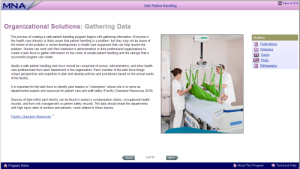
According to the U.S. Department of Labor, the profession of nursing has one of the highest nonfatal injury rates in the country, more than twice the national average. Injury rates for nurses are significantly higher than those in professions such as mining and construction (BLS 2009). The Bureau of Labor Statistics now classifies health care patients as a direct cause of on-the-job injury. A back injury occurs every 30 minutes among health care workers in America; nursing is one of the occupations at highest risk for injury. Eighty-seven percent of nurses report low back pain, 38% of nurses suffer back pain or injuries severe enough to require time off from work at some point in their careers, and 44% of injured nurses are unable to return to the nursing profession. (Sigvardsson & Bogue, 2004).
Moving patients with impaired mobility is part of a nurse’s job, but it places an unhealthy level of strain on the nurse’s body. Despite National Institute of Occupational Safety and Health (NIOSH) recommendations to limit weight lifted per individual patient care activity to 35 lbs (15.8 kg) (Waters 2007). However, during an average 8- or 12-hour shift nurses may cumulatively lift over 1.8 tons (3,600 lbs) (Tuohy-Main 1997).
Safe patient handling techniques are required for all patients admitted to the hospital for medical/surgical treatments. Nurses must be educated about these techniques in order to properly assist in moving patients of all ages and sizes. What can be done to assist nurses with properly lifting and moving patients? Most patients need help moving, and almost all of them weigh more than 35 lbs. How can nurses move these patients without suffering from lifelong pain? Nurse can be involved in promoting their health care institutions to develop comprehensive patient handling programs which benefit both patients and workers.
Work-Related Asthma in Nurses and Their Co-Workers
Credit hours: 0.90
This program will enable nurses and others to recognize signs and symptoms of work-related asthma and other health effects from exposure to chemicals and other products in the healthcare environment, as well as advocate for safer products to protect the health of nurses, other healthcare providers, and their patients.
Workplace Violence Prevention
Credit hours: 1.00
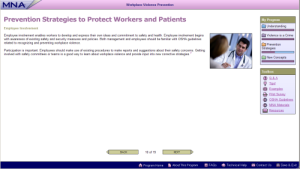
According to the National Institute for Occupational Safety and Health (NIOSH): Health care is the second-fastest-growing sector of the U.S. economy, employing over 12 million workers. Women represent nearly 80% of the health care work force. Health care workers face a wide range of hazards on the job, including needlestick injuries, back injuries, latex allergy, violence, and stress.
Although it is possible to prevent or reduce health care worker exposure to these hazards, health care workers actually are experiencing increasing numbers of occupational injuries and illnesses. Rates of occupational injury to healthcare workers have risen over the past decade. By contrast, two of the most hazardous industries, agriculture and construction, are safer today than they were a decade ago.